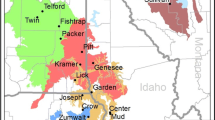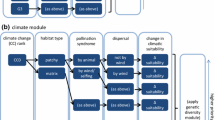Abstract
Hemlock woolly adelgid (Adelges tsugae Annand) (HWA) is an invasive forest insect sweeping across the native range of eastern (Tsuga canadensis [L.] Carr.) and Carolina (Tsuga caroliniana Engelm.) hemlocks, threatening to severely reduce eastern hemlock extent and to push Carolina hemlock to extirpation. HWA poses a significant threat to these eastern US natives, now infesting hemlocks across 19 states and more than 400 counties. For the long-term preservation of the species, ex situ genetic resource conservation efforts such as seed collection, storage, and adelgid-resistant hemlock breeding may all be necessary. To ensure the efficient and effective application of these efforts, it will be necessary to prioritize locations within the native ranges, because it is logistically impossible to apply these efforts to all populations. To build upon 12 years of seed banking for eastern and Carolina hemlock, we applied a novel approach for incorporating multiple dissimilar data sets into a geographic prioritization of areas for the most effective and efficient conservation of genetic diversity. The approach involves integration of geographic information systems with the multi-attribute frontier mapping technique to identify locations across the ranges of these two imperiled species most in need of conservation actions. Specifically, our assessment incorporated four genetic diversity parameters, a climate component, a measure of population disjunctiveness, a measure of local hemlock abundance, and seed collection density to prioritize areas of eastern and Carolina hemlock occurrence for ex situ gene conservation. For each species, the result was a mapped index of locations prioritized by the combined significance of these factors. For eastern hemlock, this assessment assigned the highest priority to disjunct populations and to some areas within the main-body range. With Carolina hemlock, disjunct northern populations and central main-body locations received the highest prioritization. Our prioritization approach could be applied similarly to other species facing pressure from invasive pests or other environmental threats.




Similar content being viewed by others
References
Abatzoglou JT (2013) Development of gridded surface meteorological data for ecological applications and modelling. Int J Climatol 33(1):121–131. doi:10.1002/joc.3413
Bechtold WA, Patterson PL (2005) The enhanced forest inventory and analysis program: national sampling design and estimation procedures. USDA Forest Service, Southern Research Station, Asheville
Bottrill MC, Joseph LN, Carwardine J, Bode M, Cook C, Game ET, Grantham H, Kark S, Linke S, McDonald-Madden E, Pressey RL, Walker S, Wilson KA, Possingham HP (2008) Is conservation triage just smart decision making? Trends Ecol Evol 23(12):649–654. doi:10.1016/j.tree.2008.07.007
Butin E, Porter AH, Elkinton J (2005) Adaptation during biological invasions and the case of Adelges tsugae. Evol Ecol Res 7(6):887–900
Campbell AR (2014) Assessing Carolina hemlock (Tsuga caroliniana Engelm.) population genetic structure and diversity in the southern Appalachians using microsatellite markers. M.S., North Carolina State University, Raleigh, NC
Costa SD, Skinner M, Parker BL (2004) HWA cold-hardiness: towards defining limits of range expansion. In: Proceedings, XV USDA interagency research forum on gypsy moth and other invasive species 2004, pp 19–22
Dukes JS, Pontius J, Orwig D, Garnas JR, Rodgers VL, Brazee N, Cooke B, Theoharides KA, Stange EE, Harrington R, Ehrenfeld J, Gurevitch J, Lerdau M, Stinson K, Wick R, Ayres M (2009) Responses of insect pests, pathogens, and invasive plant species to climate change in the forests of northeastern North America: what can we predict? Can J For Res 39:231–248. doi:10.1139/X08-171
Eckert CG, Samis KE, Lougheed SC (2008) Genetic variation across species’ geographical ranges: the central-marginal hypothesis and beyond. Mol Ecol 17:1170–1188
ESRI (2014) ArcGIS 10.3. Environmental Systems Research Institute Inc., Redlands
Galatowitsch S, Frelich LE, Phillips-Mao L (2009) Regional climate change adaptation strategies for biodiversity conservation in a midcontinental region of North America. Biol Conserv 142:2012–2022. doi:10.1016/j.biocon.2009.03.030
Gapare WJ, Aitken SN, Ritland CE (2005) Genetic diversity of core and peripheral Sitka spruce (Picea sitchensis (Bong.) Carr) populations: implications for conservation of widespread species. Biol Conserv 123:113–123
Hamrick JL, Godt MJW, Sherman-Broyles SL (1992) Factors influencing levels of genetic diversity in woody plant species. New For 6:95–124
Hansen RW (1991) Cold-hardiness in the hemlock woolly adelgid. Final rep. USDA-APHIS, Otis Methods Development Center, Otis ANGB, MA
Havill NP, Campbell CS, Vining TF, LePage B, Bayer RJ, Donoghue MJ (2008) Phylogeny and biogeography of Tsuga (Pinaceae) inferred from nuclear ribosomal ITS and chloroplast DNA sequence data. Syst Bot 33:478–789
Havill NP, Salom SM (2014) Biology and control of hemlock woolly adelgid. USDA Forest Service, Forest Health Technology Enterprise Team, Morgantown, West Virginia. FHTET Technology Transfer Series
Heller N, Zavaleta ES (2009) Biodiversity management in the face of climate change: a review of 22 years of recommendations. Biol Conserv 142:14–32. doi:10.1016/j.biocon.2008.10.006
Hewitt GM (1999) Post-glacial re-colonization of European biota. Biol J Linnean Soc 68:87–112
Hodge GR, Lopez JL, Acosta JJ, Woodbridge WC, Jump R, Jetton RM, Whittier WA, McGee JR, Gutierrez E (2017) Camcore 2016 annual report. North Carolina State University, Raleigh
Intergovernmental Panel on Climate Change (IPCC)—Data Distribution Centre (DDC) (2011). Retrieved January 29, 2017, from http://www.ipcc-data.org/ddc_faqs.html
Jaramillo-Correa JP, Beaulieu J, Khasa DP, Bousquet J (2009) Inferring the past from the present phylogeographic structure of North American forest trees: seeing the forest for the genes. Can J For Res 39:286–307
Jetton RM, Dvorak WS, Whittier WA (2008) Ecological and genetic factors that define the natural distribution of Carolina hemlock in the southeastern United States and their role in ex situ conservation. For Ecol Manag 255(8–9):3212–3221. doi:10.1016/j.foreco.2008.01.032
Jetton RM, Whittier WA, Dvorak WS, Rhea JR (2013) Conserved ex situ genetic resources of eastern and Carolina hemlock: eastern North American conifers threatened by the hemlock woolly adelgid. Tree Plant Notes 70:59–71
Johnson S, Bearer S, Hille A, Stout S, Turcotte R (2016) Eastern hemlock conservation: a collaborative approach to prioritization through a diverse partnership. Environ Pract 18(2):94–105
Jump AS, Penuelas J (2005) Running to stand still: adaptation and the response of plants to rapid climate change. Ecol Lett 8(9):1010–1020. doi:10.1111/j.1461-0248.2005.00796.x
Koch FH, Cheshire HM, Devine HA (2006) Landscape-scale prediction of hemlock woolly adelgid, Adelges tsugae (Homoptera: Adelgidae), infestation in the southern Appalachian Mountains. Environ Entomol 35(5):1313–1323. doi:10.1093/ee/35.5.1313
Koch FH, Prestemon JP, Donovan GH, Hinkley EA, Chase JM (2016) Predicting cannabis cultivation on national forests using a rational choice framework. Ecol Econ 129:161–171. doi:10.1016/j.ecolecon.2016.06.013
Logan JA, Régnière J, Powell JA (2003) Assessing the impacts of global warming on forest pest dynamics. Front Ecol Environ 1(3):130–137
Malczewski J (2000) On the use of weighted linear combination method in GIS: common and best practice approaches. Trans GIS 4(1):5–22. doi:10.1111/1467-9671.00035
McClure MS (1989) Evidence of a polymorphic life cycle in the hemlock woolly adelgid Adelges tsugae (Homoptera: Adelgidae). Ann Entomol Soc Am 82:50–54
McClure MS (1990) Role of wind, birds, deer, and humans in dispersal of hemlock woolly adelgid (Homoptera: Adelgidae). Environ Entomol 20:258–264
McClure MS, Salom SM, Shields KS (2003) Hemlock woolly adelgid. USDA Forest Service, Morgantown, WV, 14 p., FHTET-2001–03
Myking T (2002) Evaluating genetic resources of forest trees by means of life history traits - a Norwegian example. Biodivers Conserv 11(9):1681–1696
Oten KLF, Merkle SA, Jetton RM, Smith BC, Talley ME, Hain FP (2014) Understanding and developing resistance in hemlocks to the hemlock woolly adelgid. Southeast Nat 13:147–167. doi:10.1656/058.013.s610
Paradis A, Elkinton J, Hayhoe K, Buonaccorsi J (2008) Role of winter temperature and climate change on the survival and future range expansion of the hemlock woolly adelgid (Adelges tsugae) in eastern North America. Mitig Adapt Strat Glob Change 13:541–554. doi:10.1007/s11027-007-9127-0
Parker BL, Skinner M, Gouli S, Ashikaga T, Teillon HB (1999) Low lethal temperature for hemlock woolly adelgid (Homoptera: Adelgidae). Environ Entomol 28:1085–1091
Potter KM, Dvorak WS, Crane BS, Hipkins VD, Jetton RM, Whittier WA, Rhea R (2008) Allozyme variation and recent evolutionary history of eastern hemlock (Tsuga canadensis) in the southeastern United States. New Forest 35:131–145
Potter KM, Jetton RM, Dvorak WS, Frampton J, Rhea JR (2010) Ex situ seed collections represents genetic variation in natural stands of Carolina hemlock. In: Proceedings of the fifth symposium on hemlock woolly adelgid in the Eastern United States
Potter KM, Jetton RM, Rhea R, Whittier WA (2012) Widespread inbreeding and unexpected geographic patterns of genetic variation in eastern hemlock (Tsuga canadensis), an imperiled North American conifer. Conserv Genet 13(2):475–498. doi:10.1007/s10592-011-0301-2
Potter KM, Crane BS, Hargrove WW (2017) A United States national prioritization framework for tree species vulnerability to climate change. New For. doi:10.1007/s11056-017-9569-5
Preisser EL, Oten KLF, Hain FP (2014) Hemlock woolly adelgid in the eastern United States: what have we learned? Southeast Nat 13(Special Issue 6):1–15
Rew RK, Davis GP, Emmerson S, Davies H (1997) NetCDF user’s guide for C, an interface for data access, version 3. Unidata Program Center, Boulder. http://www.unidata.ucar.edu/software/netcdf/docs/netcdf. Accessed 7 Jan 2015
Rhea JR, Jetton RM (2010) Framework for genetic conservation of eastern (Tsuga canadensis) and Carolina (T. caroliniana) hemlock. In: Onken B, Reardon R (eds) Fifth symposium on hemlock woolly adelgid in the Eastern United States, Asheville, North Carolina, 2010. USDA Forest Service, Forest Health Technology Enterprise Team, pp 106–121
Rink G (1990) Butternut. In: Burns RM, and Barbara H. Honkala (ed) Silvics of North America: 2. Hardwoods. Agricultural Handbook 654. United States Department of Agriculture Forest Service, Washington D.C
Sanford T, Frumhoff PC, Luers A, Gulledge J (2014) The climate policy narrative for a dangerously warming world. Nat Clim Change 4:164–166. doi:10.1038/nclimate2148
Schaberg PG, DeHayes DH, Hawley GJ, Nijensohn SE (2008) Anthropogenic alterations of genetic diversity within tree populations: implications for forest ecosystem resilience. For Ecol Manag 256(5):855–862. doi:10.1016/j.foreco.2008.06.038
Sgro CM, Lowe AJ, Hoffmann AA (2011) Building evolutionary resilience for conserving biodiversity under climate change. Evol Appl 4:326–337
Skinner M, Parker BL, Gouli S, Ashikaga T (2003) Regional responses of hemlock woolly adelgid (Homoptera: Adelgidae) to low temperatures. Environ Entomol 32(3):523–528. doi:10.1603/0046-225X-32.3.523
Souto D, Luther T, Chianese B (1996) Past and current status of hemlock woolly adelgid in eastern and Carolina hemlock stands. In: Salom SM, Tigner T, Reardon R (eds) First hemlock woolly adelgid review. US Forest Service, Morgantown, pp 9–15
Tanis SR, McCullough DG (2015) Host resistance of five Fraxinus species to Agrilis planipennis (Coleoptera: Buprestidae) and effects of paclobutrazol and fertilization. Environ Entomol 44(2):287–299
United States Department of Agriculture, Forest Service (2017) Alien forest pest explorer. https://foresthealth.fs.usda.gov/portal/Flex/APE. Accessed 5 Feb 2017
United States Geological Survey (1999) Digital representation of “Atlas of United States Trees” by Elbert L. Little Jr. United States Geological Survey. http://esp.cr.usgs.gov/data/atlas/little/. Accessed 25 June 2013
Willi Y, Van Buskirk J, Hoffmann AA (2006) Limits to the adaptive potential of small populations. Annu Rev Ecol Evol S 37:433–458
Woudenberg SW, Conkling BL, O’Connell BM, LaPoint EB, Turner JA, Waddell KL (2010) The forest inventory and analysis database: database description and users manual version 40 for phase 2. USDA Forest Service, Rocky Mountain Research Station, Fort Collins
Yanchuk AD, Lester DT (1996) Setting priorities for conservation of the conifer genetic resources of British Columbia. For Chron 72:406–414
Yemshanov D, Koch FH, Ben-Haim Y, Downing M, Sapio F, Siltanen M (2013) A new multicriteria risk mapping approach based on a multiattribute frontier concept. Risk Anal 33:1694–1709. doi:10.1111/risa.12013
Acknowledgements
We would like to thank Heather Dinon Aldridge and Corey Davis at the Southeast Climate Science Center for their support with the climate datasets and their proper implementation. This work was supported in part by the Pine Integrated Network: Education, Mitigation, and Adaptation Project (PINEMAP) funded by the USDA National Institute of Food and Agriculture, Award #2011-68002-30185. This work was also supported through Research Joint Venture Agreement 13-JV-11330110-072 between the U.S. Department of Agriculture, Forest Service, Southern Research Station, and North Carolina State University and Grant Agreements 11-DG-11083150-011 and 12-DG-11083150-016 between the U.S. Department of Agriculture, Forest Service, Forest Health Protection and Camcore, North Carolina State University.
Author information
Authors and Affiliations
Corresponding author
Electronic supplementary material
Below is the link to the electronic supplementary material.
Rights and permissions
About this article
Cite this article
Hastings, J.M., Potter, K.M., Koch, F.H. et al. Prioritizing conservation seed banking locations for imperiled hemlock species using multi-attribute frontier mapping. New Forests 48, 301–316 (2017). https://doi.org/10.1007/s11056-017-9575-7
Received:
Accepted:
Published:
Issue Date:
DOI: https://doi.org/10.1007/s11056-017-9575-7




